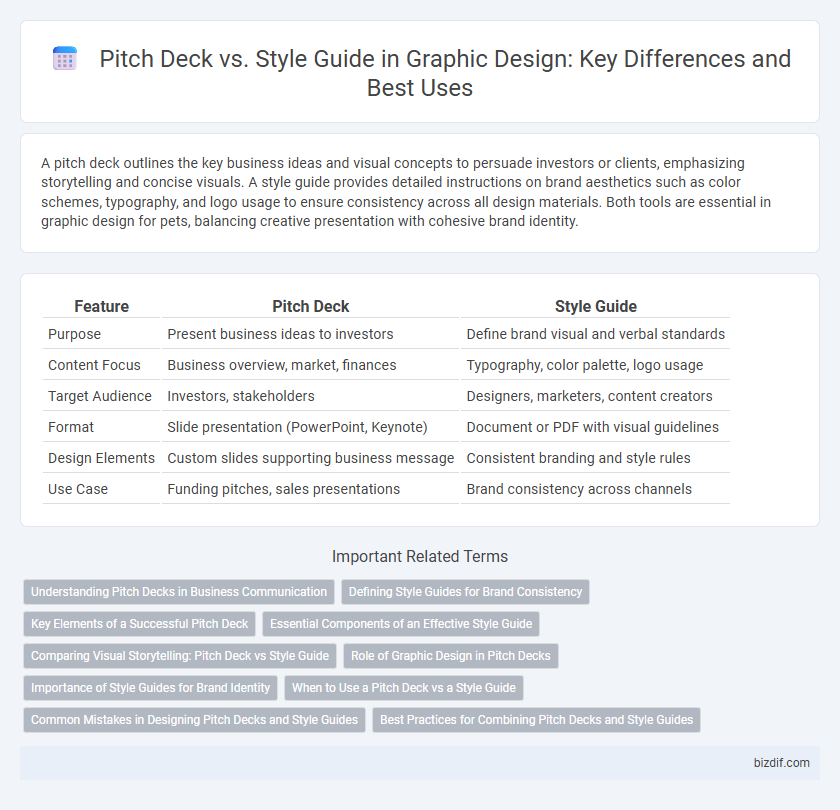A pitch deck outlines the key business ideas and visual concepts to persuade investors or clients, emphasizing storytelling and concise visuals. A style guide provides detailed instructions on brand aesthetics such as color schemes, typography, and logo usage to ensure consistency across all design materials. Both tools are essential in graphic design for pets, balancing creative presentation with cohesive brand identity.
Table of Comparison
| Feature | Pitch Deck | Style Guide |
|---|---|---|
| Purpose | Present business ideas to investors | Define brand visual and verbal standards |
| Content Focus | Business overview, market, finances | Typography, color palette, logo usage |
| Target Audience | Investors, stakeholders | Designers, marketers, content creators |
| Format | Slide presentation (PowerPoint, Keynote) | Document or PDF with visual guidelines |
| Design Elements | Custom slides supporting business message | Consistent branding and style rules |
| Use Case | Funding pitches, sales presentations | Brand consistency across channels |
Understanding Pitch Decks in Business Communication
Pitch decks serve as concise presentations aimed at investors, outlining a business's value proposition, market opportunity, and financial projections to secure funding or partnerships. They prioritize clarity, visual impact, and persuasive storytelling to effectively communicate complex ideas in a limited timeframe. Unlike style guides, which establish consistent brand aesthetics and design rules, pitch decks focus on strategic message delivery and business outcomes in graphic design.
Defining Style Guides for Brand Consistency
Defining style guides ensures brand consistency by outlining specific design elements such as color palettes, typography, and logo usage, which maintain a uniform visual identity across all marketing materials. Unlike pitch decks that focus on presenting ideas and business strategies to stakeholders, style guides serve as a comprehensive reference for designers to create cohesive graphics that align with the brand's voice. Consistent application of style guide standards strengthens brand recognition and fosters trust among audiences.
Key Elements of a Successful Pitch Deck
A successful pitch deck includes clear value propositions, concise problem statements, and compelling visual storytelling to engage investors effectively. Key elements are a strong opening slide, detailed market analysis, and a well-defined business model paired with financial projections. Unlike a style guide, which maintains brand consistency through color schemes and typography, the pitch deck prioritizes narrative flow and persuasive content tailored to fundraising goals.
Essential Components of an Effective Style Guide
An effective style guide in graphic design includes essential components such as precise logo usage guidelines, a defined color palette with HEX and RGB codes, and standardized typography specifications specifying font families, sizes, and weights. It also contains clear instructions on imagery style, iconography, and spacing rules to ensure brand consistency across all materials. These elements collectively maintain visual coherence, support brand identity, and streamline collaboration for design teams.
Comparing Visual Storytelling: Pitch Deck vs Style Guide
Pitch decks prioritize dynamic visual storytelling to captivate investors through concise narratives, compelling imagery, and cohesive slide designs that emphasize brand potential and market opportunity. Style guides serve as comprehensive references ensuring consistent brand identity across all visual and verbal communications by detailing typography, color palettes, iconography, and usage rules. Both tools shape visual storytelling but differ in purpose: pitch decks persuade through storytelling arcs, while style guides maintain brand coherence over time.
Role of Graphic Design in Pitch Decks
Graphic design plays a crucial role in pitch decks by visually communicating a startup's brand identity and key messages, helping to engage investors effectively. Well-crafted visuals, including cohesive color schemes, typography, and imagery, ensure clarity and professionalism, which are essential in capturing attention and conveying trustworthiness. Unlike style guides that serve as comprehensive brand manuals, pitch decks utilize graphic design strategically to create compelling narratives that drive investor interest and decision-making.
Importance of Style Guides for Brand Identity
Style guides are essential for maintaining consistent brand identity across all visual materials, ensuring that logos, typography, colors, and imagery align with the brand's values and messaging. Unlike pitch decks, which are tailored presentations focused on specific projects or investors, style guides provide comprehensive rules and standards that guide all design decisions and communications over time. Consistent use of a well-defined style guide enhances brand recognition, builds trust, and strengthens the overall market presence.
When to Use a Pitch Deck vs a Style Guide
A pitch deck is essential for presenting business ideas, startup concepts, or product proposals to investors and stakeholders, focusing on vision, strategy, and key metrics. A style guide is critical for maintaining consistent brand identity across all design elements, including logos, typography, and color schemes, ensuring uniformity in communication. Use a pitch deck during initial business presentations and investor meetings, while a style guide is required during ongoing design and marketing projects to uphold brand standards.
Common Mistakes in Designing Pitch Decks and Style Guides
Common mistakes in designing pitch decks include overcrowding slides with excessive text and inconsistent visual elements that dilute brand messaging. Style guides often suffer from vague typography rules and lack of clear color palette specifications, leading to inconsistent design applications. Both require precise alignment of content and visuals to effectively communicate branding and project goals.
Best Practices for Combining Pitch Decks and Style Guides
Integrating pitch decks with style guides ensures visual consistency and brand alignment, enhancing the impact of presentations. Use predefined color palettes, typography, and logos from the style guide while designing pitch decks to maintain professional coherence. Regularly update both documents in tandem to reflect evolving brand standards and messaging strategies.
Pitch Deck vs Style Guide Infographic

 bizdif.com
bizdif.com